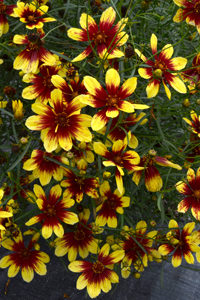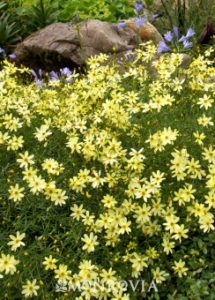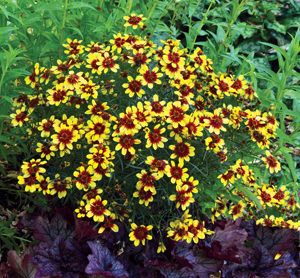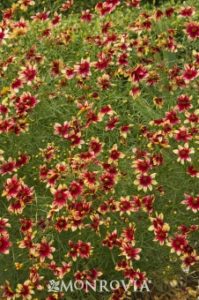
Tickseed – Coreopsis ‘Bengal Tiger’ Photo Terra Nova Nurseries
Coreopsis colorful easy low-water plantings
As a Portland landscape designer I use Coreopsis verticillata and its’ cultivars because it’s a perfect colorful, low maintenance plant for modern landscape designs, bee friendly gardens, cottage gardens, container gardens and low-water plantings.
Clients love it because it flowers for such a long time from summer into fall. Coreopsis is beloved.
I wrote this blog to help clients understand which Coreopsis will live for years and which ones will not. Coreopsis verticillata is one of about five species of Coreopsis that are native to the United States. Many people feel that Coreopsis verticillata will grow too wide after about five years and will need to be divided. A lot of my younger clients are so focused on low-maintenance plants that I typically don’t include any plants that need to be divided in their plans. I still have this old-fashioned idea that I can provide a planting plan where all the plants will last 20 years and the trees forever. However, if I really stick to that I’m shorting my busy young clients of some plants that are going to do very well for a long enough period of time. Digging up a plant every five years chopping it in half, tossing half of it or giving it away, and then re-planting half of it is less work than having to buy a new plant.
So if you are still interested in a low maintenance easy plant that has to be divided read on.

Coreopsis verticillata ‘Moonbeam’ is perfect for a bee friendly garden.
Another asset, Coreopsis verticillata hits its color stride after all the May and June flowers have faded in the heat. I am still picking flowers for my bathroom posy in late September. It’s a perfect fit for a bee friendly garden. You could start your bee feeding year with winter flowering heather, then Spanish lavender then English lavender and finish the year with Coreopsis.
I personally use Coreopsis in small bathroom bouquets. I love it’s ferny foliage texture and the strong zap of color. But it’s a great addition to any flower arrangement. They are so cheerful.
Here are some trustworthy choices easily available at most nurseries.
Coreopsis verticillata varieties
‘Creme Brule’ versus ‘Moonbeam’
When ‘Moonbeam’ came out in the 1990’s it was possibly the most popular perennial of all times. Nurseries could not keep it in stock. It has dark green ferny foliage while ‘Creme Brule’ has a bright emerald green ferny foliage. ‘Creme Brule’ is taller and has a soft yellow flower which is larger than ‘Moonbeam’. The stems are stronger as well but while many claim that ‘Creme Brule’ is more mildew resistant, I have not found this to be true. ‘Creme Brule’ tends to have flowers from the lower stems to the top which I find attractive. ‘Moonbeam’ tends to carry the flowers only at the top of the plant. ‘Moonbeam’ will be a little cheaper as it’s been around longer in the nurseries then ‘Creme Brule’. They are both great plants.
‘Zagreb’: is named for the capital of Croatia. When you think of the trouble those people have been through and have persevered it makes sense that this plant carries that name. This plant is incredibly yellow and tough. I don’t typically recommend it because I have had problems with it reseeding and making a nuisance of its’ self in some areas. I use it for incredibly difficult environments where having it spread won’t matter. Obviously, this would not work for small city landscapes except as a low maintenance mass planting.

Coreopsis verticillate ‘Bengal Tiger’ Photo credit Terra Nova
‘Bengal Tiger’: select this plant for the amazing color contrast of red and gold. It is similar to a plant called ‘Route 66’. The flowers on ‘Bengal Tiger’ will be more consistent whereas the flowers on ‘Route 66’ will be very different from each other on the same plant which some people feel looks a little muddy.
How to care for Coreopsis Verticillata
Plant in a well draining soil or up on a berm. I’ve seen this plant do well at the edge of a lawn too. To keep it flowering cut the plant back by half in mid summer. I have cut back ‘Moonbeam’ Coreopsis up to 3 times in one summer to keep it flowering until fall.
How to kill a Coreopsis
To kill this plant, plant it in a low spot with heavy mucky clay and it will die or over water it. It comes back in the late spring so don’t be fooled and start to dig it up and kill it. Be patient. The dark green foliage is lacy and can be hard to see when the tiny shoots first emerge from the soil.
Companion plantings
I like to plant Coreopsis verticillata varieties with low water plants like Yucca ‘Golden Ribbon’, Caryopteris ‘Blue Mist’. It’s a great texture complement to ornamental grasses like American Switch Grass, ‘Heavy Metal’ or Blue Oat Grass. A mass planting of Coreopsis in the foreground with dwarf conifers and a ‘Gilt Edge’ Silverberry shrub in the background is a very simple low maintenance plant composition. For the cottage garden you can’t beat Coreopsis ‘Moonbeam’ with Nepeta cat mint and shrub roses like ‘Happy Chappy’ or David Austin rose ‘Graham Thomas’.
There are a lot of different species of Coreopsis out there and it’s buyer beware. You have to pay attention to the names of the plants because there are some Coreopsis that make a nuisance of themselves and will seed all over your yard. Many Coreopsis varieties are short lived so I tend to stick with these five. My Portland garden design clients love this plant for low maintenance, drought tolerant, and color in the summer landscape.
For more information on drought tolerant landscaping, contact and make an appointment.





